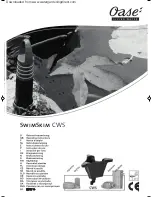
3–600 Page 14
When ordering parts lists or repairs, always give size
and serial number of pump. Serial number is stamped
on the pump nameplate attached to frame and also on
a raised pad located on upper side of the power frame
at the fluid cylinder end.
If the serial number cannot be identified, obtain several
photographic views of the power frame and fluid cylin-
ders, including part numbers of principal castings
which should furnish us clues as to the identity of the
pump.
SPECIAL CARE OF PUMP IN STORAGE – Piston rod
packing and piston packing must be removed, if the
pump is not put in service immediately. Permitting
packing to remain in an idle pump for a period of time
will tend to create rusting and pitting of liner bore and
piston rods.
Puller kit parts for removing valve seats, liners and
crosshead pin bushings may be purchased from Gard-
ner Denver Machinery Inc.
OPERATING SPEEDS AND PRESSURES – See bul-
letins for operating speeds and pressures for type of
service.
All displacements are theoretical with piston rod vol-
ume deducted. For actual delivery deduct from 5% to
10% for slippage using 10% at maximum RPM.
Pressures are maximum permissible
with rated maximum piston rod loads
and MUST NEVER BE EXCEEDED.
While it is true that reducing the speed reduces the
horsepower practically in direct proportion, the piston
load for which the pump is designed is a function of the
fluid pressure against the piston. Reducing the speed
to half and doubling the pressure requires approxi-
mately the same horsepower but results in 100% over-
load on the power end.
Maximum input BHP and shaft RPM shown in bulletins
MUST NEVER BE EXCEEDED under any operating
conditions. These speeds are recommended for favor-
able suction conditions and consideration must be giv-
en to viscosity and character of fluid.
DO NOT operate these pumps below
40 RPM as this will hinder proper lu-
brication.








































